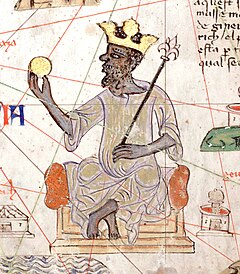Mansa (title)

Mansa (N'Ko: ߡߊ߲߬ߛߊ;[1] pl. mansaw) is a Maninka[2] and Mandinka[3] word for a hereditary[1][4] ruler, commonly translated as "king".[5][6][7] It is particularly known as the title of the rulers of the Mali Empire, such as Mansa Musa, and in this context is sometimes translated as "emperor".[8] It is also a title held by traditional village rulers, and in this context is translated as "chief".[1]
Mansa contrasts with another Manding word for ruler, faama. Faama emphasizes the military, coercive authority of a ruler,[9] and can be translated as "tyrant",[10] whereas mansa refers to a hereditary ruler whose authority is derived from tradition[1] and mystical power.[9] A ruler can be both a faama and a mansa, but a mansa was not necessarily a faama.[9]
The word mansa (Arabic: منسا, romanized: mansā) was recorded in Arabic during the 14th century by North African writers such as Ibn Battuta and Ibn Khaldun, who explained it as meaning "sultan".[11] Cognates of mansa exist in other Mandé languages, such as Soninke manga, Susu menge, and Bambara masa.[2] Vydrin also compared it to mensey, the Guanche word for their rulers.[1] According to Misiugin and Vydrin, the original meaning of the root word was probably "chief of hunters" or "chief of warriors".[2]
An alternate translation of mansa, which Jansen attributes to the followers of Marcel Griaule, is that mansa means "god", "the divine principle", or "priest-king". Jansen notes that they have not provided their reasoning for choosing this translation.[6]
List of Mansas[edit]
References[edit]
- ^ a b c d e Vydrin 2015, p. 260.
- ^ a b c Misiugin & Vydrin 1993, p. 105.
- ^ Schaffer 2005, p. 333.
- ^ Jansen 1996, p. 99.
- ^ Macbrair 1839, p. 40.
- ^ a b Jansen 1998, p. 256.
- ^ Conrad & Condé 2004, pp. xv, 198–199.
- ^ Sutton 1997, p. 221.
- ^ a b c Chappatte 2022, p. 22.
- ^ Vydrin 2015, p. 218.
- ^ Levtzion & Hopkins 2000, pp. 289, 333.
Works cited[edit]
- Chappatte, André (2022-11-01). In Search of Tunga: Prosperity, Almighty God, and Lives in Motion in a Malian Provincial Town. University of Michigan Press. ISBN 978-0-472-22074-8.
- Conrad, David C.; Condé, Djanka Tassey (2004). Sunjata: a West African epic of the Mande peoples. Indianapolis: Hackett. ISBN 0-87220-697-1.
- Jansen, Jan (1996). "The representation of status in Mande: did the Mali Empire still exist in the Nineteenth Century?". History in Africa. 23: 87–109. doi:10.2307/3171935. hdl:1887/2775. ISSN 0361-5413. JSTOR 3171935. S2CID 53133772.
- Jansen, Jan (1998). "Hot Issues: The 1997 Kamabolon Ceremony in Kangaba (Mali)". The International Journal of African Historical Studies. 31 (2): 253–278. doi:10.2307/221083. hdl:1887/2774. ISSN 0361-7882. JSTOR 221083.
- Levtzion, Nehemia; Hopkins, John F. P., eds. (2000) [1981]. Corpus of Early Arabic Sources for West Africa. New York, NY: Marcus Weiner Press. ISBN 1-55876-241-8.
- Macbrair, R. Maxwell (1839). A grammar of the Mandingo language: with vocabularies. London.
- Misiugin, Viacheslav M.; Vydrin, Valentin F. (1993). "Some archaic elements in the Manden epic tradition: the "Sunjata Epic" case". St. Petersburg Journal of African Studies. 2: 98–111. ISSN 1025-4544.
- Schaffer, Matt (2005). "Bound to Africa: the Mandinka Legacy in the New World". History in Africa. 32: 321–369. doi:10.1353/hia.2005.0021. eISSN 1558-2744. ISSN 0361-5413. S2CID 52045769. Retrieved 2022-04-13.
- Sutton, J. E. G. (1997). "The African Lords of the Intercontinental Gold Trade Before the Black Death: al-Hasan bin Sulaiman of Kilwa and Mansa Musa of Mali". The Antiquaries Journal. 77: 221–242. doi:10.1017/S000358150007520X. eISSN 1758-5309. ISSN 0003-5815. S2CID 129875132.
- Vydrin, V. F. (2015). Manding-English Dictionary: (Maninka, Bamana). Volume 1, A, B, D-DAD. Lac-Beauport: MeaBooks Inc. ISBN 978-0-9939969-3-1.

